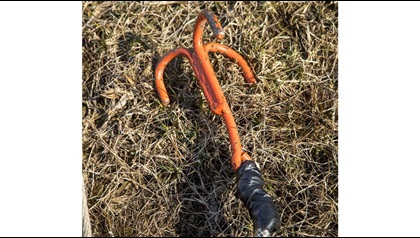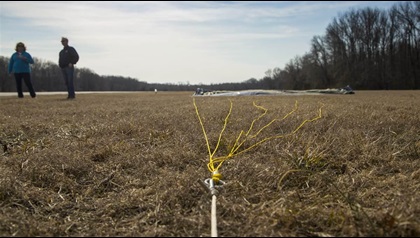What went wrong? Imperiled pickup
Critical mistake in gusty conditions proves too difficult for a pilot on North Carolina’s Outer Banks

Located six nautical miles southwest of First Flight Airport (FFA) at the Wright Brothers National Memorial, Dare County Regional Airport (MQI) hosts multiple commercial operators that offer everything from flight training, helicopter rides, and charters to skydiving, aerobatic rides, and aerial banner towing.
The bulk of the aerial banner season falls between Memorial and Labor days, and on summer weekdays banners advertising both local and national businesses fly north along the coast starting typically between 10 and 11 a.m. until around 6 or 7 p.m. Towing ceases only during the most severe weather. Some businesses buy specific time slots—Tuesday morning, Thursday afternoon, or Wednesday at precisely 12. For special events such as weddings, proposals, and birthdays, time is critical down to the minute.
Stalls and spins are familiar threats—taught almost from day one of flight training. But the biggest hazard in a pick isn’t stalling.
On June 27, 2018, pilots, ground crew, and operators prepared to get another day of towing underway. That morning the wind was gusting from the southeast, which one experienced local pilot noted as “unusual.” The banner field, where banners are laid out to be picked up from between two approximately six-foot-tall poles commonly referred to as the “sticks,” is fixed and runs parallel to Runway 5/23. The wind from 120 degrees at 10 knots, gusting to 14, created an almost direct crosswind to the banner field. Trees more than 80 feet tall adjacent to the field increase mechanical turbulence. Below the tree line—where a pilot operates for takeoff, landing, and banner picks and drops—the wind can be even more variable than what’s reported on the AWOS.
Successful banner towing requires both excellent stick-and-rudder skills and disciplined aeronautical decision making. In each phase of flight, from pickup to tow to banner drop, there’s little room for error, especially since most towing occurs at less than 1,000 feet agl. The slim margin for mistakes means towing is higher risk than most general aviation endeavors.



Pilots do not take off with a banner attached to the airplane. They instead use a grappling hook attached via approximately 12 feet of cable to a tow assemblage under the tail of the airplane to pick the banner off the ground. The FAA notes in its “Information for Banner Towing Operations” document that the banner pickup is the most critical portion of a tow. A banner “pick” is an aggressive, full-power, high angle of attack nose-up maneuver, all while low to the ground—and the tall trees at Dare County necessitate a more aggressive pick maneuver than what is used at fields without nearby obstacle. An inadvertent stall during a pick would be a challenge to recover from, and a spin would likely be unrecoverable.
Stalls and spins are familiar threats—taught almost from day one of flight training. But the biggest hazard in a pick isn’t stalling. It’s interference of the tow rope with the fuselage or control surfaces of the airplane—either as a result of improper hook deployment or flying through the sticks too low, typically an altitude of 10 feet agl or less. This can be avoided by following without compromise two cardinal rules: Always check your hook, and never come in low.
For the first pick of a flight, the pilot typically departs from the most favored runway, deploys the hook from the cockpit of the airplane (usually through an open window or door) so that it hangs about 12 feet behind and below the tail of the airplane, and enters a 500-foot pattern for the banner field. The approach to the sticks, where the tow rope is attached to the banner, is made at an angle similar to or slightly steeper than a normal landing approach.
The pilot makes an effort to guide the hook through the sticks as close to straight as possible. If the grappling hook hits one of the sticks, which are often PVC pipe at Dare County, the stick will likely shatter and require replacement before the banner pick can take place. Coming through the sticks straight also helps the banner peel off the ground without getting tangled on itself. Before and above the sticks, full power is applied, and the pilot rotates into a nose-up attitude to swing the hook through the sticks, hopefully grabbing the tow rope in the process. By always initiating the nose-up segment of the pick before the sticks, a pilot helps ensure that the fuselage/tail/gear of the airplane is never introduced to the tow rope, even if the pilot has approached low.
When the banner begins to come off the ground, drag increases dramatically and aircraft performance degrades. At the top of a pick there is no extra energy available other than nosing over—horsepower and airspeed are spent. On hot, high-density-altitude days, even at sea level, a pilot may need close to or full power just to maintain an appropriate towing altitude. Should an emergency occur during any phase of towing, the first action item is to release the banner using a lever typically located near the pilot’s feet.
At approximately 10:20 a.m., a 35-year-old commercial pilot taxied out in the towplane, a Cessna 150J with a 180-horsepower Lycoming O-360 engine, to take off and enter the pattern for a pick from the banner field parallel to 5/23 for his first tow of the day. With the wind coming from 120 degrees, most aircraft were using Runway 17 that morning. After the pilot took off, deployed the hook, and entered the pattern, he approached the sticks for the pickup.
A ground crewman working in the banner field watched the airplane approach and line up with the sticks. He noted that the airplane was “very low” and estimated that the tail was about five feet off the ground, which would have put it below the top of the sticks. In this case, the grappling hook was likely hitting the ground as it dragged behind the very low airplane. The witness stated that as the airplane flew through the pickup area, the pickup loop got caught around the left elevator. He recalled that the pilot made a radio call to the ground crew stating, “I can’t turn, it won’t release.” The pilot may not have even realized that he had picked the tow rope with the tail of the airplane.
The witness stated that as the airplane flew through the pickup area, the pickup loop got caught around the left elevator. He recalled that the pilot made a radio call to the ground crew stating, “I can’t turn, it won’t release.”The single ground crewmember watched the airplane continue north and stated that when the airplane was “barely over” the tops of the trees, the airplane made a climbing left turn toward the trees north of the 5/23 centerline, possibly in an attempt to return to the field for a landing. The ground crew member noted that the wind was blowing from right to left and that it seemed to be “pushing” the airplane—and the banner—north toward the tall trees. He watched as the airplane disappeared behind the tree line. Another witness stated that the airplane appeared to enter an aerodynamic stall. The airplane wreckage was found in between trees adjacent to the airport perimeter; the pilot was killed.
The National Transportation Safety Board determined the probable cause of this accident to be a loss of control because of the banner tow rope becoming entangled in the left horizontal stabilizer in crosswind conditions.
Why?
This was the accident pilot’s first season banner towing. The pilot’s training records revealed he successfully completed a proficiency check for banner-tow operations on May 7, 2018, six weeks prior to the mishap. The FAA traveled to Dare County on May 10, 2018, to observe the accident pilot complete a successful banner pick-up and drop off. The owner of the banner towing company estimated that the accident pilot had flown approximately 75 hours since that observation—beginner hours in the towing world, where a pilot can easily log five or more hours in a busy day.
For a new banner tow pilot, it is a challenge to visualize where the grappling hook is hanging below the airplane during the pickup rotation, and it is easy to seek out the familiar landing sight picture and aim instead with the tail of the airplane—which is a serious error. The difference between the two risk profiles—acceptable and unacceptable, high enough and too low—can come down to a matter of inches.
The near-direct gusty crosswind and turbulent conditions that day reduced the pilot’s already slim margin for error. Lining up with the sticks and fighting the wind likely required constant control inputs, and focus on the gusts may have inhibited the pilot from realizing how low he was.
A pick with the tail in a 150 is a serious emergency, but it does not automatically lead to a fatal crash. Before towing solo, pilots are trained how to land with a banner just as student pilots train for engine-out scenarios. With the right conditions, it is possible for a pilot to come back around, very carefully, and land with the banner still attached via the tail. On this day, the wind may have made that impossible even for an experienced banner tow pilot.
Takeaways
The hardest part of towing is discipline—discipline never to come in low; to always check your hook; and to fly slow enough, often right at the edge of a stall, for the banner to be readable. When you’re starting out, you miss picks. When it’s windy, even the most experienced pilots can miss picks occasionally. Desperation for a successful pick—and perhaps anticipation of missing in gusty wind—coupled with the time pressure inherent to towing can lead to errors, such as coming in too low, determined to get the banner on the first try.
Do pilots “get away” with picking low? Absolutely. And whether that’s from lack of experience or honest mistakes, it dramatically increases the chance of a serious emergency occurring during the flight. While most of us are not flying in an environment with such severe and immediate consequences following a single decision or error, as in banner towing, we have opportunities to either increase or decrease the odds of a favorable outcome to our flight. Sometimes, there’s no room to compromise.
Risk fluctuates throughout a flight, and it’s up to us as pilots in command to make sure that the risk is manageable and acceptable. Before you make a decision in flight, ask what the potential consequences of that decision are. Are you willing to accept—and are you accepting on behalf of your passengers—the worst possible outcome? When coming in low for a banner pick, the worst case is to pick with the fuselage, as the accident pilot did. For him, it proved unrecoverable.



